- HOME
- Activities
- Project
- Project Details
KIP2020 Project “A Role of Sending the Messages and A Responsibility of Communicating with People about Natural Disasters.”
Outline
1.Are you aware of reputational damage cases?
2.Introducing Facts to eliminate Harm
3.Do you buy vegetables and fruits from Fukushima Prefecture without hesitation?
4.Does a decrease in opportunities to gain information lead to continued reputational damage?
5.What is an ideal way to spread information of natural disasters?
6.Does a decrease in opportunities to gain information lead to continued reputational damage?
7. What has COVID-19 brought about?
8. How is your action linked to reputational damage after getting information related to COVID-19 from the media?
9. Do you think you can be spreading rumors?
10. How "Convenient" Communication Affect Our Lives
11. How to interact with the media, based on the role of the media - Through interviews with two journalists
12. Communication among Citizens Regarding Natural Disasters
13. Transmitting information in Community ~What we learned through a regional study to Kochi~
14. What can we do?
15. The importance of thinking of the invisible
【Article 1| Are you aware of reputational damage cases?】
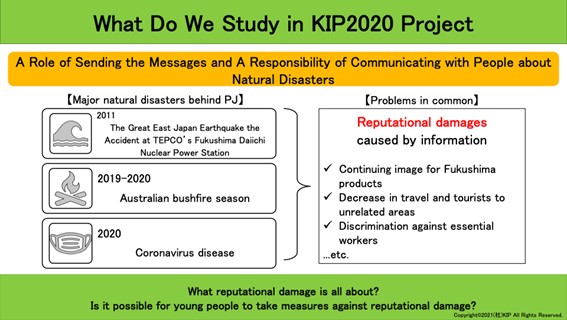
It goes without saying that information has a great influence on the activities of people and organizations. On one hand, it is better to have more information, such as when preparing for school exams and, when conducting market analysis for job hunting and business planning. In recent years, more and more people might be feeling this way with the spread of the Internet. On the other hand, we need to be diligent with how we deal with information. Once false information or fake news is disseminated, it is possible that an innocent individual or a specific community will be slandered. Moreover, our society as a whole can be in turmoil.
This year, we, the KIP2020 Project team, launched our project to think about such negative impacts of information on our society. Disinformation that harms the reputation of individuals and organizations was circulating after natural disasters across the globe. For example, school children and some industries experienced adverse impacts from the Great East Japan Earthquake and the accident at TEPCO’s Fukushima Daiichi Nuclear Power Station accident that occurred in March 2011. In the aftermath of this disaster, some students were reportedly bullied at school in areas where they had evacuated, and agricultural and marine products produced in Fukushima went down in prices. When we turned overseas for related events, a large-scale wildfire broke out and spread mainly in the mountainous areas of southeastern Australia in 2019. The horrific images of the fire have spread all over the world, and the number of tourists even in districts completely free from wildfires has decreased. According to the press, the local people suffered from financial damages.
Furthermore, the COVID-19 pandemic in 2020 can be regarded as a kind of natural disaster. We also confirmed that there were discriminatory actions or remarks and prejudices against essential workers such as medical workers and delivery drivers.
The KIP2020 project has uniquely defined "psychological damage to people along with economic consequences caused by the failure to disseminate factually correct information" as "reputational damage." We have continued our research regarding the mechanism and examples of these reputational damages since June 2020 with the following two goals.
① To deepen our understanding through literature review, surveys, and interviews.
② To take some feasible measures as young people.
As a part of this project, we decided to send out information about what we have found through our research on reputational damage and messages to those who have been hurt by the phenomenon under the #ThinkingofYou campaign. Details of the #ThinkingofYou campaign is coming up in the next post on January 31st. Join us in thinking about the reputational damage that actually exists around us.
(References)
OTOA(2020) “Australia/Australia Wildfire updates [Translated from Japanese]” (2020/12/12 accessed)
Nippon Keizai Shimbun (2017) “129 cases of Fukushima evacuation bullying, first surveyed by the Ministry of Education, Culture, Sports, Science and Technology in 2016 [Translated from Japanese]” (2020/12/12 accessed)
Kahoku Shimbun (2020) “The reality of rumors (1) Price difference from Fukushima [Translated from Japanese]” (2020/12/12 accessed)
Nippon Keizai Shimbun (2020) “Newspaper Association and National Association of Commercial Broadcasters make a statement to eliminate discrimination and prejudice [Translated from Japanese]” (2020/12/12 accessed)
Planned and edited by: Knowledge Investment Program, Inc.
Sponsored by: Toshiba International Foundation
Chubei Itoh Foundation
【Article2|Introducing Facts to eliminate Harm】
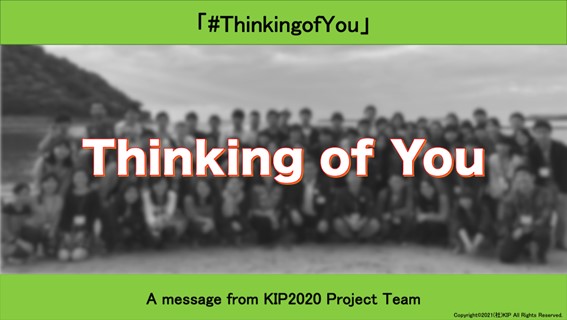
What can we, young people do to deal with the problems caused by disinformation? Is it possible to take measures against reputational damage that inevitably occurs? It may be natural to have such questions. The Internet and SNS are spaces where people belonging to various ideologies, religions, and cultures come together. It can be said that it is a place like a crucible, where each person can express their opinions and values. This also means that these online spaces are also flooded with information provided from various perspectives. Given that, it seems quite difficult to discern the truth and take some action to nip reputational damage in the bud.
However, young people like us who are digital natives might be able to play a role in disseminating information and sharing facts through the Internet and social media. In addition, we feel that it is our responsibility for those who have helped us deepen our insights through interviews and the like by sharing their thoughts with others. From those viewpoints, we have been discussing what we can do.
Our answer was to take action and extend our hearts to those who suffered from reputational damage as well as reduce the number of potential victims and perpetrators of future damage. Thus, we launch the #ThinkingofYou campaign. Our goal is to create an opportunity to learn about what reputational damage is all about.
Through this campaign, we would like to convey the message, "We may not be able to provide direct support, but we haven’t forgotten about you." "Let’s fight against groundless rumors and fake news!" to those who have suffered reputational damage. We would also like to disseminate information on reputational damage and its related data to “potential perpetrators,” namely all of us living in modern society where it is easier to obtain and share information. Educating the public on reputational damage, we hope to reduce the number of future victims and perpetrators. To this end, through the "#ThinkingofYou" campaign, we are sharing actual situations and data of reputational damage extracted from our survey, as well as the voices of those who have been affected by natural disasters and journalists who have been covering them, collected in our interviews. We hope that each post will give you a chance to think about reputational damage, which is actually relevant to us.
Planned and edited by: Knowledge Investment Program, Inc.
Sponsored by: Toshiba International Foundation
Chubei Itoh Foundation
【Article3|Do you buy vegetables and fruits from Fukushima Prefecture without hesitation?】
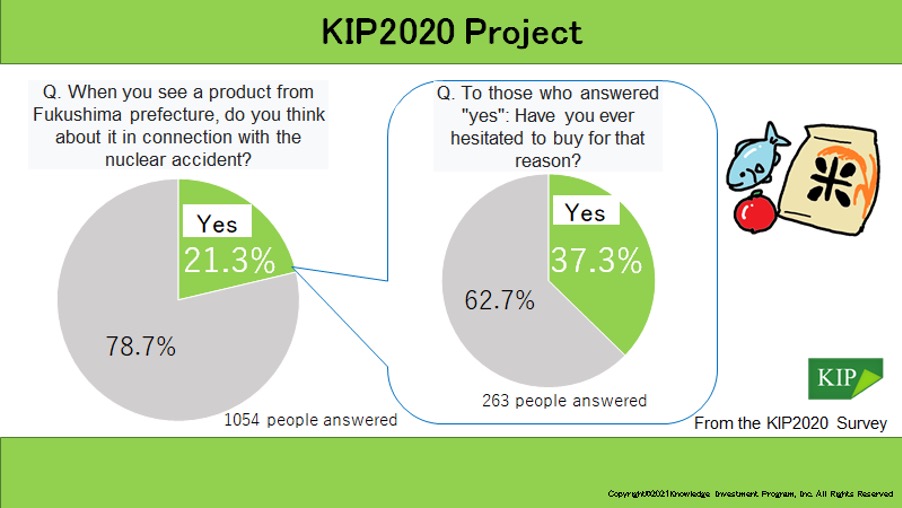
Have you ever avoided buying produce and seafood harvested in Fukushima Prefecture?
Since the accident at TEPCO’s Fukushima Daiichi Nuclear Power Station in March 2011, reputational damage to agricultural products worsened in Fukushima and other Tohoku prefectures, which has continued until now. From July to August 2020, the KIP2020 Project team conducted a questionnaire entitled “A survey on Youth Attitude Toward Reputational Damage” to investigate how much reputational damage of Fukushima due to the accident at TEPCO’s Fukushima Daiichi Nuclear Power Station still exists.
In the survey which received 1,054 responses from university students and young professionals in 2020, 21.3% of the respondents answered that they have associated products from Fukushima Prefecture with the accident at TEPCO’s Fukushima Daiichi Nuclear Power Station. In addition, 37.3% of them expressed that they had hesitated to purchase products from Fukushima because of the nuclear accident. This demonstrates that some people still refrain from purchasing products from Fukushima by linking them to the nuclear accident occured as long as ten years ago.
The year 2021 marks ten years after the nuclear accident. Is produce from Fukushima Prefecture really unsafe? In fact, in Fukushima, after the inspection of all bags of rice [1], for instance, radioactive material did not exceed the standard for any bag since 2015 [2]. Furthermore, in areas outside those where evacuation orders were issued due to the nuclear accident, Fukushima moved from a total bag survey to a sampling inspection with smaller volume of samples. Based on these scientific results, rice produced in Fukushima does not seem to be any less safe than rice produced in other regions in Japan. However, as indicated in the KIP 2020 Survey, some people still associate the accident with Fukushima-made products. Even though the government, companies and farmers, have been taking various measures to eliminate the reputational damage, it seems that such negative association persists.
What can we do in order to be not fooled by reputational damage? We think that one of the keys is to examine the data of radiation levels detected from consumer products in Fukushima and the voices of those living in these areas. We encourage you to choose what you consume based on correct information for the sake of your own health as well as those who produce the products. In this article, we introduced three things: the fact that reputational damage has continued to this day, what might be the cause of such persistent damage, and what we can do as individuals.
Note: [1] Total volume inspection is to inspect all rice bags by using a belt conveyor type inspection device to inspect the amount of radioactive substances.
[2]Yomiuri Shimbun. Inspection of all bags of rice produced in Fukushima prefecture, extraction inspection from the new year ... Excluding evacuation orders from municipalities.
Planned and edited by: Knowledge Investment Program, Inc.
Sponsored by: Toshiba International Foundation
Chubei Itoh Foundation
【Article4|Does a decrease in opportunities to gain information lead to continued reputational damage?】
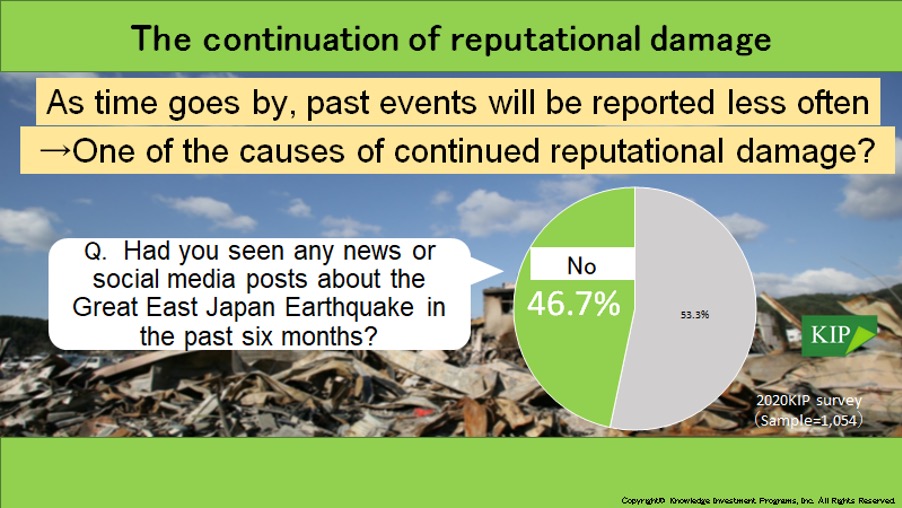
We––The KIP2020 Project team––have researched the problems that arise in the process of conveying information triggered by natural disasters, and tried to disseminate information about the problems and why and how they have occurred.
In this article, we focus on the link between fading news coverage and reputational damage. As time goes by, past events will be reported less often. This may seem obvious, but it may actually be causing the continuation of reputational damage.
Day after day, various events occur in Japan and abroad. We can see what happens in faraway places only through web-based media, including mass media and social media instead of confirming them with our own eyes. In the 2020 KIP Survey (KIP's original questionnaire on reputational damage, targeting about 1,000 university students and young adults), the mass media (i.e., TV, newspapers, etc.) was the most used source of information by young people to obtain information about natural disasters, especially the Accidents at Fukushima. In fact, according to the Ministry of Public Management, Home Affairs, and Posts and Telecommunications, the mass media is the most popular source of information for all generations ranging from those in their 20s to 60s in Japan[1].
However, there is a limit to what the mass media can report. We can understand that the mass media gives priority to the latest information and controversial events in everyday broadcast. For example, about half of the respondents answered "No" to the question "Have you seen any news or social media posts about the Great East Japan Earthquake within the past six months?” in the KIP Survey 2020. Ikutame and Harukawa (2020) of Tohoku Fukushi University revealed that the number of nationwide news reports on the Great East Japan Earthquake in both Asahi and Yomiuri newspapers––major news outlets in Japan––decreased significantly between the first and the second year after the earthquake and has been slowly declining since then [2]. Hara and Ohtaka (2019) of the Media Research Department of NHK's Broadcasting Culture Research Institute also found that the time spent on news related to the disaster in nighttime anchor programs diminished gradually[3].
Such phenomenon is generally called "news fading.”There are two negative impacts of this phenomenon that have been identified t so far.
Firstly, the decrease in media coverage about areas affected by natural disasters, people living in those areas, and their lives discourages others who did not directly experience the disasters to remember them, which in turn causes economic damage. This is because the amount of news coverage is, to some extent, proportional to the amount of financial support the local people recieve. If a situation where people need help is not reported properly, such support might come to an end, even when there are still those in need.
Secondly, “news fading” increases misinformation , as the opportunity to share the current situation disappears. In the 2020 KIP survey, about 20% of respondents still associate Fukushima with nuclear power plant when purchasing products. If everyone has a correct understanding of the current situation, we may be able to improve the reputational damage.
Note: [1] Ministry of Internal Affairs and Communications, "FY 2016 Information and Communications White Paper," 2016, pp. 165-187.
[2]Ikuta and Harukawa, "A Study of Eight Years of Newspaper Reports on the Accident at the Fukushima Daiichi Nuclear Power Plant: Effects on Residents' Health Damage," Bulletin of Tohoku Fukushi University, Vol. 44, 2020, pp. 97-114.
[3]Specifically, it has been pointed out that the time spent on disaster-related news coverage after the occurrence of the disaster was less than one fifth in 2012, , and less than 1/250,000 in 2018, compared to the time when the disaster occurred. Hara and Otaka, "How 3.11 is Told and Passed Down: An Examination of Television Coverage Seven Years after the Great East Japan Earthquake," NHK Broadcasting Culture Research Institute Annual Report, 2019, Vol. 63, pp. 67-129.
Planned and edited by: Knowledge Investment Program, Inc.
Sponsored by: Toshiba International Foundation
Chubei Itoh Foundation
【Article5|What is an ideal way to spread information of natural disasters?】
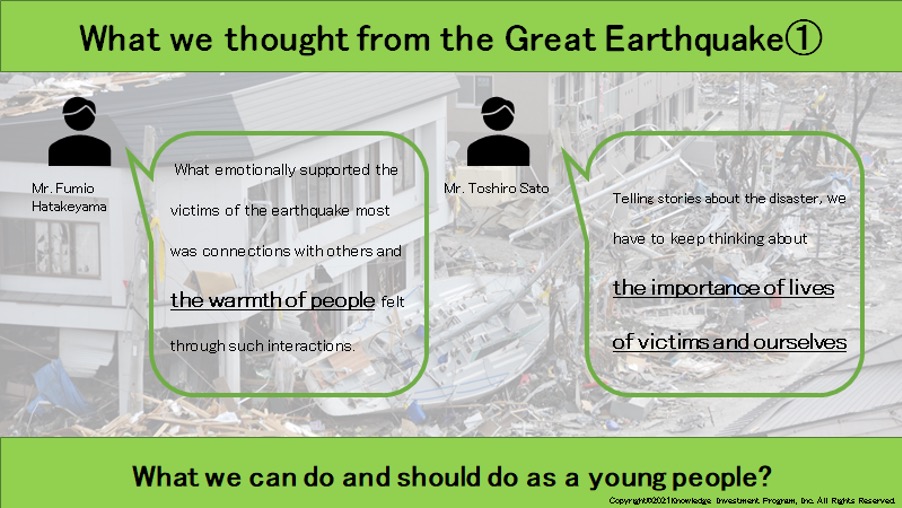
In August and October 2020, the KIP 2020 Project team spoke with two people who were affected by the Great East Japan Earthquake.We interviewed Fumio Hatakeyama, who served as the president of the community association at the Heisei-no-mori temporary housing complex in Minami Sanriku Town, Miyagi Prefecture, and Toshiro Sato, who lost his second daughter who was in sixth grade to the Great East Japan Earthquake, and continues to provide testimonies of the earthquake. In the next two articles, we will share what we learned from these interviews.
Hatakeyama said what supported the victims of the earthquake the most emotionally was connections with others and the warmth of people felt through such interactions. Tea parties and frank conversations with other residents of the temporary housing, for example, helped them a lot. Frequent visits from those outside of the residence also put a smile on their faces even under such hard circumstances. Learning how the warmth through face-to-face interaction greatly helped those who had gone through tragedy reassured our belief in human connection.
Sato told us the importance and difficulty of talking about how he and his community were affected by the Great East Japan Earthquake to other people. It is such a traumatic experience that he finds it very hard to speak about it and always has a mix of emotions. But thinking about the lives that we could not save and the lives that wanted to be saved, he emphasized the importance of talking about the tragedy and moving forward as someone who continues to share his experience with others. Although it is often the case that what people experienced through the natural disaster greatly changes how they look at it, Sato pointed out that we should overcome those differences and focus on what is at stake: human lives. In order to do so, he maintained that it is essential to “harmonize” with others, meaning having your own stance but, simultaneously, listening to others and trying to find a good balance between diverse views.. What struck us was that he further explained that we need to create an environment that enables such “harmony” which encourages everyone to openly express themselvesThrough his interview, we deeply felt our responsibility of passing down the stories of those affected by natural disasters.
Hatakeyama also alluded to the COVID-19 pandemic, comparing it to the Great East Japan Earthquake e. One of the lessons learned from the earthquake was to never assume that disasters won’t happen to ourselves,which he claimed to have helped establish measures to prevent the infection. On the other hand, he was concerned that the human connections and warmth which used to mentally support the temporary housing residents after the earthquake was fading away. This was because they had seen each other less often since they moved to public housing. To make matters worse, the COVID-19 pandemic has been forcing people to stay away from each other, making them feel more lonely.
He added that he wanted young people to send out information and messages, making good use of social media. Since we are accustomed to utilizing the Internet, we strongly felt that we have to live up to his expectations.
Overall, these interviews suggested that we acknowledge our role and R responsibility in educating people about and discussing natural disasters when disseminating information to connect people. We would be grateful if you learned something from this article and take action.
hank you, Mr. Hatakeyama and Ms. Sato, for your cooperation in these interviews.
Our next post about another lesson learned from the interviews––the importance of building trust and awareness of disaster prevention in normal times––will be released on February 14th. Please stay tuned!
Planned and edited by: Knowledge Investment Program, Inc.
Sponsored by: Toshiba International Foundation
Chubei Itoh Foundation
【Article6|Would it be okay to think about disaster when it’s here ? How effective is preparing for crises in normal times?】
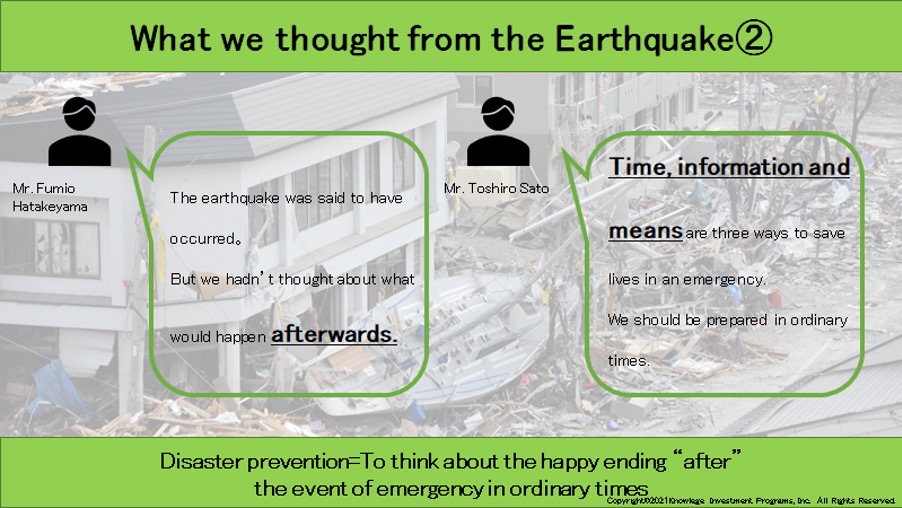
In August and October 2020, the KIP 2020 Project team spoke with two people who were affected by the Great East Japan Earthquake.We interviewed Fumio Hatakeyama, who served as the president of the community association at the Heisei-no-mori temporary housing complex in Minami Sanriku Town in Miyagi Prefecture, and Toshiro Sato, who lost his second daughter who was in sixth grade to the Great East Japan Earthquake, and continues to provide testimonies of the earthquake. In the next two articles, we will share what we learned from these interviews.
In this article, we would like to focus on the importance of building trusting relationships and awareness of disaster prevention during normal times, which are essential for saving lives in times of disaster.
Sato's daughter was a student at Okawa Elementary School in Ishinomaki City in Miyagi Prefecture at the time of the earthquake. The school was hit by a tsunami that left 74 out of 108 students dead or missing, and killed 10 teachers. The tsunami came about 50 minutes after the earthquake. Just before the arrival of the tsunami, the children had been in the low-lying schoolyard. There was a nearby mountain where they could evacuate. In fact, some parents and neighbors encouraged them to evacuate, and some children called out, "Let's run off to the mountain.”In Sato’s words , they had the time, means, and information to save lives, but the children only actually started moving one minute before the tsunami arrived, resulting in a large number of casualties.
Why did this happen? One of the reasons was the lack of awareness of disaster prevention during normal times. Hatakeyama of Minamisanriku Town told us that people in Miyagi knew for a long time that a big earthquake was coming to the area. But they did not have a clear plan on how to deal with it. Sato shared his insights on why people were reluctant to prepare for crises. Thinking about disasters that threaten ourselves and our loved ones’ lives is too scary that people avoid seriously thinking about the possibility of having to deal with natural disasters.
Also, many people may assume that having a manual would be sufficient to handle an emergency. However, there were cases where many lives were lost in an emergency, because of the lack of regular reviews or discussions on the content after manuals were made in normal times. Sato cited three conditions that could save lives in an emergency: time, information, and means. In case of an emergency, people are forced to make decisions with overwhelmingly limited time and information. In order to make better decisions under such circumstances, it is essential to have a solid simulation in normal times, not only for each individual but also for an organization.
In particular, the case of Okawa Elementary School that Sato shared occurred in a school setting, and it called into question how a group or an organization should deal with disasters. “School teachers are not just people who happen to be in the school,” said Sato. The word "school" can be replaced by the words "company" or "community" as well.
We may be reluctant to think of disaster prevention, viewing disasters as something “bad” and to be “prevented”. What struck us about Sato's talk, however, was that disaster prevention meant including ourselves and our loved ones in the story, and thinking about the happy ending. We hope that the Great East Japan Earthquake will be used as an example to think about how to respond to the potential Nankai Trough, the direct earthquake in the capital, and the eruption of Mount Fuji. In this sense, Sato believes that Okawa Elementary School is not a tragic place, but a place that 'opens up the future.’
In addition to preparing for the future as individuals, we must also build trust and dialogue on a daily basis within the groups and organizations we belong to, and prepare for the future in a concrete way. We think that is what we can do now for ourselves and our loved ones.
Thank you, Mr. Hatakeyama and Ms. Sato, for your cooperation in these interviews.
Our next topic, released on February 14th, will be about the anxiety and behavioral changes induced from the novel coronavirus infection. Don't miss it!
Planned and edited by: Knowledge Investment Program, Inc.
Sponsored by: Toshiba International Foundation
Chubei Itoh Foundation
【Article7|What has COVID-19 brought about?】
In the previous two articles, we have introduced what we learned from interviews about natural disasters and the reputational damage. From here on out, we would like to focus on what young people think and how they behave in times of crisis within the context of reputational damage.
The KIP2020 project team conducted a questionnaire that received responses from 1,000 university students and young professionals between July and August 2020 We obtained answers to questions on reputational damage and information-gathering from all over Japan and even from abroad. In the next three articles, we would like to introduce the results of this questionnaire.
[How have our behaviors changed due to COVID-19?]
In response to the question of how the amount of communication with friends has changed after the declaration of a state of emergency in April 2020, about 70% of people answered it decreased. On the other hand, when asked the question on how the amount of time spent gathering information about the health crisis on mass or social media has changed, about 70% of respondents answered that it increased. This may suggest that the gathering information had replaced the communication with friends under the COVID-19 pandemic.
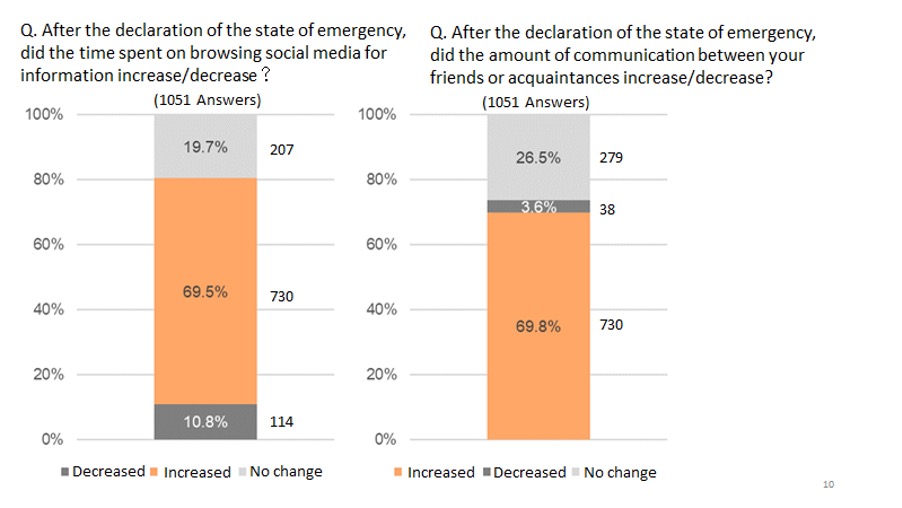
[How have our feelings changed?]
Here, we discuss the mental effects of the declaration of a state of emergency on young people. 70% of the respondents indicated that their level of anxiety increased due to the pandemic. Among them, more than 70% said that they are most concerned about the future, which surpassed the number of those who answered that the aspect of public health was most worrying, a direct threat posed by COVID-19. As young people have a lower chance of getting severe symptoms from the virus, the largest impact of the global health crisis on young people may have been the disruption of job hunting processes and putting their life on hold, increasing the uncertainty of their future.
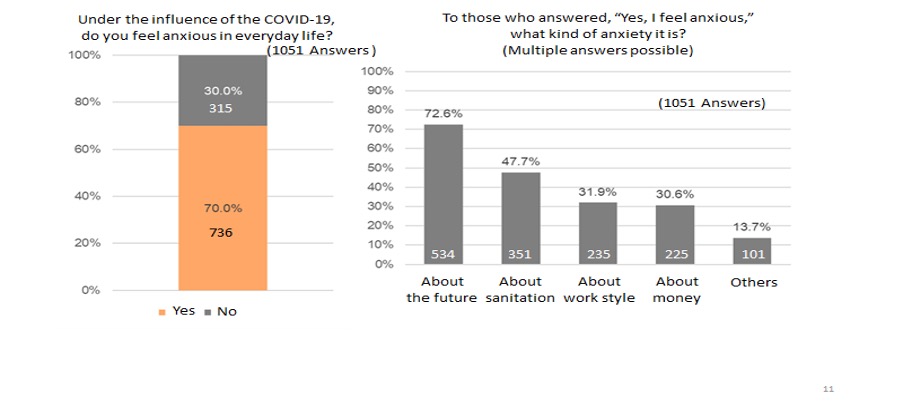
Also, interestingly, the more they had spent time on gathering information, the more they had felt anxious. It can be said that there is some kind of relation between anxiety and information-gathering.
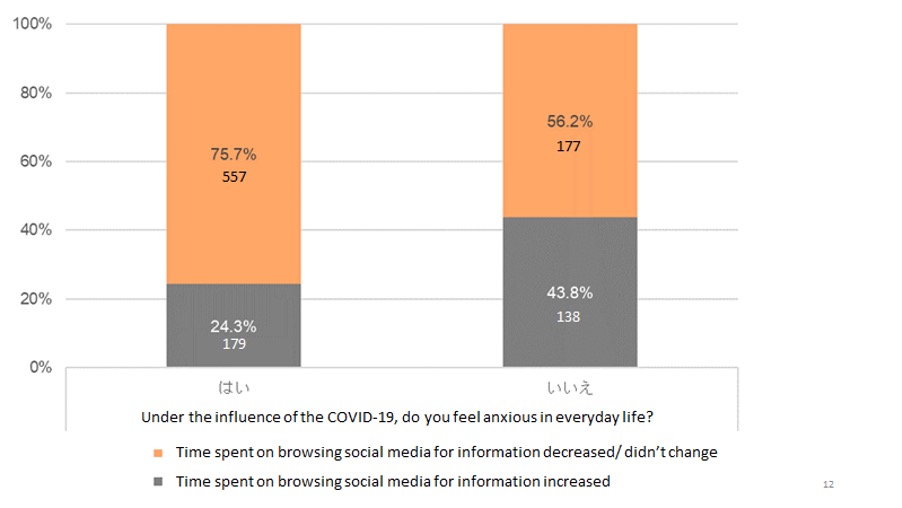
Then, how do young people behave when they receive information from social media? We will show more details in our next post on February 21st. Stay tuned!
Planned and edited by: Knowledge Investment Program, Inc.
Sponsored by: Toshiba International Foundation
Chubei Itoh Foundation
【Article8|How is your action linked to reputational damage after getting information related to COVID-19 from the media?】
In the previous article, we introduced the results of the large-scale survey of about 1,000 young people conducted as part of the KIP2020 Project from the perspective of what young people think and how they behave.
In this article, we would like to continue to pick up some of the results of this survey and introduce what young people rely as their source of information and how they react to information they gain under the COVID-19 pandemic.
[Media for acquiring COVID-19 related information and discerning the truth]
We asked which medium young people rely on the most for obtaining information on COVID-19. About 60% of the respondents answered mass media, but most prominently, about 40% said they use social media as their top information source. Furthermore, over 80% answered they fact-check COVID-19 related information they obtain on social media. This shows that some people, albeit a minority, keep the factual accuracy of the information unchecked.
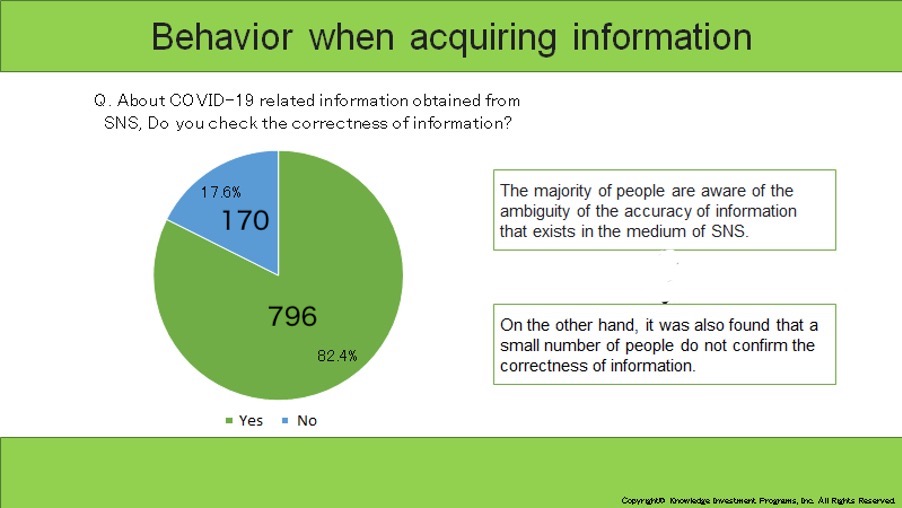
[Reaction to information obtained from social media]
How did young people react and what actions did they take after they received information from social media? About 60% answered that they don’t share COVID-19 related information they have gained on social media with others. On the contrary, about 30% answered that they would verbally share the information with the people around them, and 7.7% of the respondents said that they would react on social media, suggesting that there is some kind of information dissemination is being carried out.
Furthermore, what kinds of behaviors mean "reacting on social media"? In response to this question, more than 40% said that they would take some sort of action that clearly is intended to spread the information , such as "sharing" or "reposting it in their own words." What is interesting here is that the majority of respondents would “like” posts on COVID-19, which is unique to social media.
So what are young people’s intentions when they "like" a post on social media? And what does this act of "like" mean in terms of reputational damage? Please see the next article to learn more about it.
Planned and edited by: Knowledge Investment Program, Inc.
Sponsored by: Toshiba International Foundation
Chubei Itoh Foundation
【Article9|Do you think you can be spreading rumors?】
In the last two posts, we have presented the results of a large survey of about 1,000 young people. In our previous post, we introduced the results of the survey on behavior when young people obtained information from the media. 7.7% of the respondents answered they “react” on social media when they get COVID-19 related information on social media. Of these, 66 respondents answered they would like the posts.
The results of this survey suggest that many people “like” the information about COVID-19 when they see it on social media such as Facebook and Twitter. Is there any intention to disseminate the information obtained? We asked these 66 people the question, "Do you like the posts with the intention of spreading the information on social media? The result is here: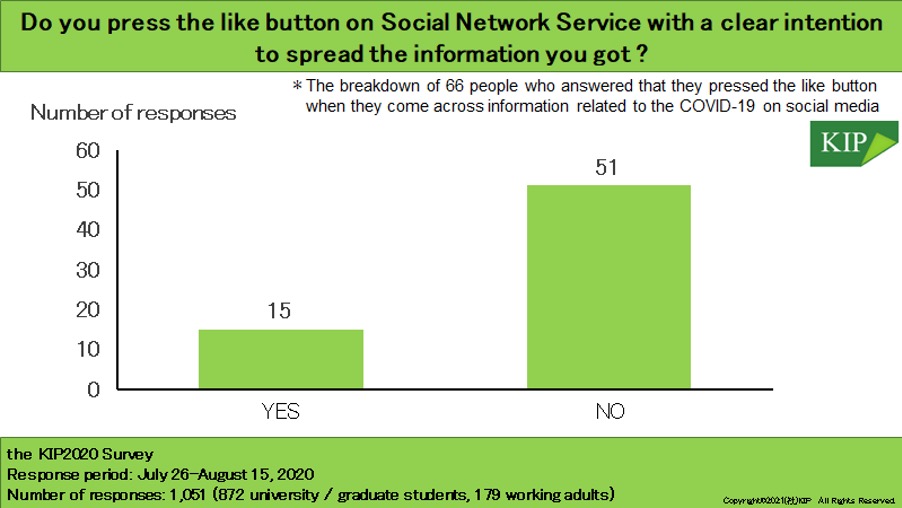
The KIP2020 Survey (Response period: July 26-August 15, 2020, Number of responses: 1,051 (872 university and graduate students, 179 working adults)
We found that 51 people, who account for more than 70% of the 66 people, do not have the intention of spreading the information when they see COVID-19 related content on social media and like it. Facebook and Twitter are designed to display posts that people liked to those who follow them. This result suggests that the information is being spread by likes even if those liking the posts have no intention of spreading them.
Careful discussion is required as to whether information dissemination on social media causes reputational damage. On the other hand, how many survey respondents think that everyone is a perpetrator of rumors? Here is the answer to the question, "Do you think you can be a perpetrator of rumors?”
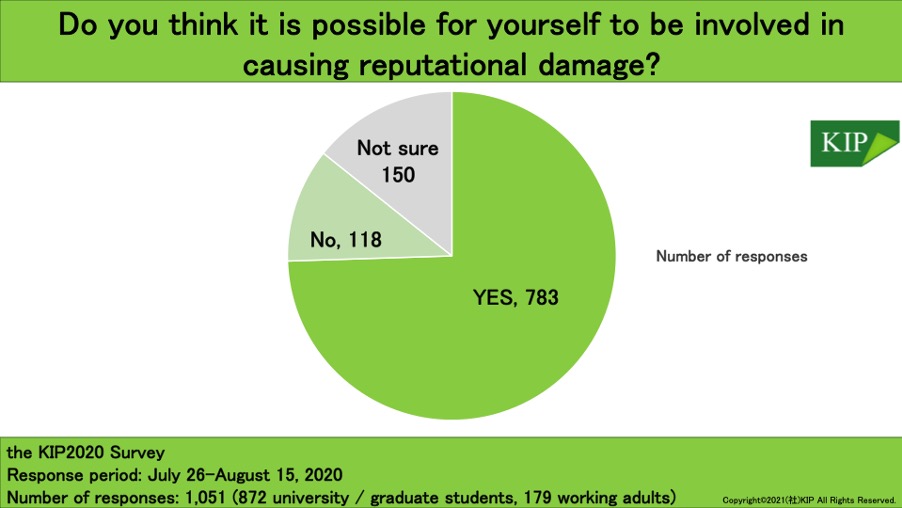
The KIP2020 Survey (Response period: July 26-August 15, 2020, Number of responses: 1,051 (872 university and graduate students, 179 working adults)
Of the 1,051 responses, 783, who account for 75%, thought they could be spreading rumors themselves. The "perpetrator of rumors" here is defined as "an entity that can have an unfavorable effect on a third party by disseminating one's own information." Of the 783 respondents who answered "yes", 325 indicated social media as the most frequent medium for acquiring COVID-19 related information. For these reasons, the KIP2020 project team has concluded that many people are aware that they may become perpetrators of rumors, mainly by disseminating information online.
So how has online communication changed? We will discuss this in our next article.
Planned and edited by: Knowledge Investment Program, Inc.
Sponsored by: Toshiba International Foundation
Chubei Itoh Foundation
【Article10|KIP2020 Project:How "Convenient" Communication Affect Our Lives】
In the previous article, we introduced the results of the large-scale survey of about 1,000 young people conducted as part of the KIP2020 Project from the perspective of what young people think and how they behave. In this article, using a survey conducted by KIP in 2018, we will show the current situation of online communication, which young people frequently use.
As we all know, online communication has already been commonly used due to the spread of SNS and communication applications such as LINE, Twitter, and Facebook. In particular, the download of LINE reached nearly 80% in 2017. [1] Based on this situation, KIP conducted a survey on young people's communication style through text messages for undergraduate and graduate students in the KIP2018 Project entitled "Convenience vs..Unintended Side Effects." There were 1103 and 228 responses respectively. One of the findings was that while young people spent a lot of time using their cell phones [2], nearly 75% of all respondents felt that they were not able to communicate well with others only through text messages and LINE. [3]
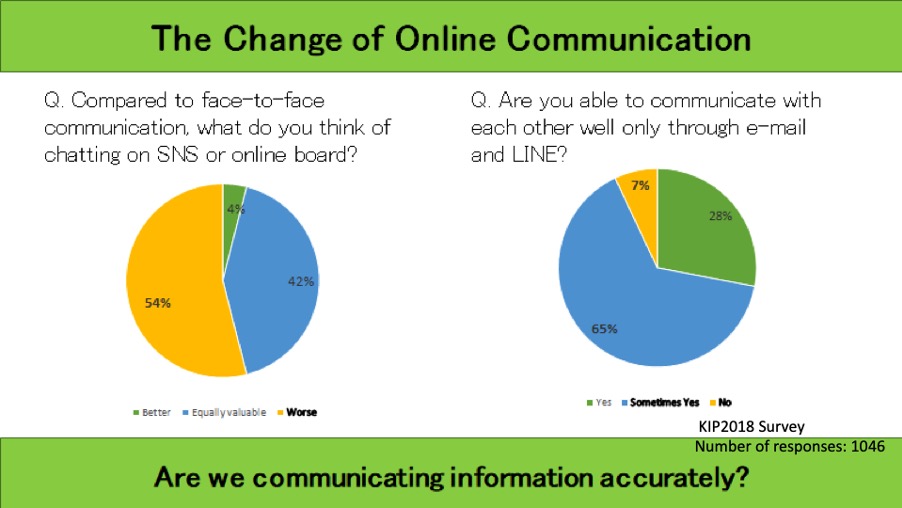
This survey also indicated that 54% of the students felt that face-to-face communication helped them interact with others better, compared to social media. [4][5]
Inferring from the results of these KIP surveys, even before the outbreak of COVID-19, young people found it difficult to understand each other enough only through exchanging text messages. The reason for this may lie in the difference in the amount of information. It can be said that text-based communication conveys less amount of information than face-to-face communication. This is because the former demands more time and greater effort texting and discourages us from responding politely. Also, in this type of communication, it can often be more difficult to obtain non-verbal information such as facial expressions and gestures than when the other person is right in front of you.
Furthermore, as mentioned in the previous article, according to the KIP2020 Survey, 69.5% of respondents reported that the amount of communication with friends and acquaintances have decreased under the COVID-19 pandemic. Given the trend of accelerated online communication influenced by COVID-19, it can be argued that forming a mutual understanding and maintaining relationships with those people trust will become more difficult. Furthermore it can be estimated that online communication will become even more accelerated, transforming the trend of communication style in society as a whole from face-to-face communication to online communication.
Under such circumstances, it may be much more difficult to share correct information about natural disasters on a daily basis. If this kind of communication becomes the norm, mutual trust can also be lost.
This may in turn trigger anxiety during a disaster, only to gather and spread information without fully ascertaining the truth.
As it is very difficult for us to control the trend of communication, we think that the first step we can take is to keep examining and asking ourselves whether we are really able to convey everything we have to say to others, through communication means we use in everyday life.
Our next post about an interview with media representatives in Kochi Prefecture will be released on February 19th. Stay tuned!
Planned and edited by: Knowledge Investment Program, Inc.
Sponsored by: Toshiba International Foundation
Chubei Itoh Foundation
[1] Ministry of Internal Affairs and Communications, a white paper on information and communications:The Emergence and Diffusion of the Internet and Changes in Communication, Reiwa 1st (2019) 総務省|令和元年版 情報通信白書|インターネットの登場・普及とコミュニケーションの変化 (soumu.go.jp)2020/12/12
[2 ]According to the KIP2018 survey, 93.4% of students check their cell phones at least once an hour.
[3] the KIP2018 survey
[4] the KIP2018 survey
[5] the KIP2018 survey
【Article11|How to interact with the media, based on the role of the media - Through interviews with two journalists】
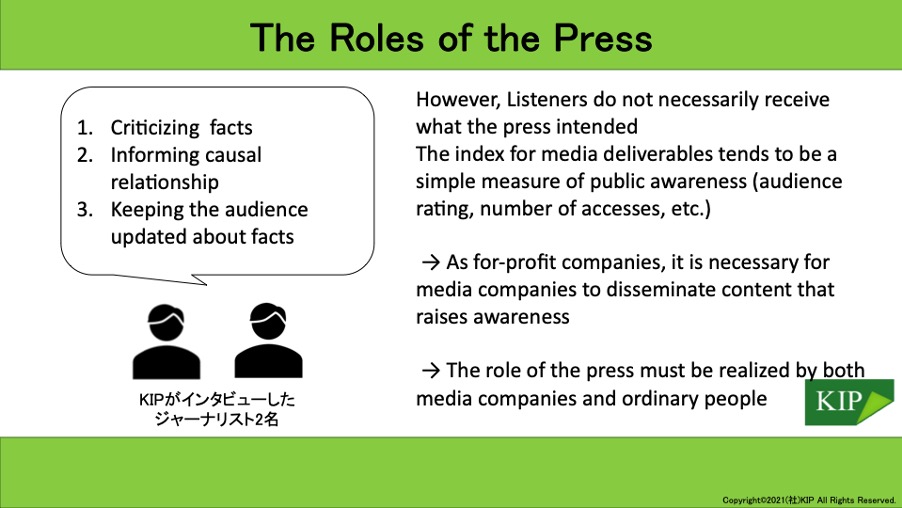
The interview began with a simple question: what is the press, and what role does the media play? The interviewees gave a clear answer: first, criticism, second, background information, and third, fixed-point observation. Needless to say, the first and second are important for the theme we are working on, “A Role of Sending the Messages and A Responsibility of Communicating with People about Natural Disasters.” If we take the term "reputational damage" (which is too complicated to be equated with the ancient phenomenon of rumors and false rumors) and analyze it, we must ask ourselves for what purpose and what kind of information mass media, the largest source of information which symbolizes the modern age, have been disseminating. As for the third purpose, although it is sometimes derided as "calendar journalism," there is no reason why it should not be meaningful for us to work on it, reminding us of the events that took place far away from us every year, events that are hard to forget and cannot be forgotten by anyone. In the interview, they also mentioned that the role of the media is to provide information in times of disaster in the context of risk communication in times of disaster where its importance is indisputable.
However, what we need to focus on first is the breadth of coverage by mass media (whether there are many definitions of news and media, we would like to focus on mass media as the interviewee's organization). There are four types of mass media, which are not necessarily superior or inferior to each other, and it goes without saying that all of them play an important role. However, when we receive information from mass media, are we ever aware of which of these purposes the information we have at hand was released for? Is it possible for the sender to convey the information as background, but the receiver to accept it as criticism? Essentially, there is a distance between "writing" and "reading," between "speaking" and "listening. The information possessed by the writer and the reader is never exactly the same. We have to accept the asymmetry of information and deal with the media and information. Naturally, more efforts on the part of mass media and other sources are required, but at the same time, it is necessary to improve the information literacy of those who receive information.
In addition, another problem is that the indicators for evaluating the products of mass media, which are sent out for different purposes, will be the common measure of public recognition (in the TV world, it will be the viewer rating, and in the Internet world, it will be the number of access). This may be a natural consequence of the market logic that products with high added value are ultimately valued by the market, but it is questionable whether it is possible to evaluate the primary role of criticism, for example. How can we evaluate, from the standpoint of simple numbers, what is originally a painful word to the ears of the majority of people, without being misled by the opinions of the public and the masses? However, it must be noted that there are deep-rooted issues that arise from the fact that these are organizations whose main purpose is profit, and even if they are not, they have a structure that can only exist with the support of a large number of people. The governance of companies and organizations that deal with news and media must be carefully considered.
It was interesting to hear firsthand from someone who works in the industry that in such companies, an individual reporter has a lot of discretion. However, this is why it would be important to set a standard for high evaluation of reporters who think hard about how to convey the facts and what the role of the media is, and who do not easily pander to the so-called voices of the public.
Lastly, a topic that came up from the speakers was the relationship between social networking sites and mass media. The two may be able to better communicate information by mutually monitoring and complementing each other. In any case, it is clear that the relationship between narrator and listener has begun to take a new step, and we strongly feel that the phenomenon of reputational damage exists in such a situation. After understanding the roles and characteristics of the media as described above, how should we, living in the age of social networking, interact with the media? How we interact with the media may be the key to reducing or eliminating reputational damage.
Look forward to our next article where we discuss communication among citizens that we learned during a regional study to Kochi, especially from the perspective of disaster prevention.
【Article12|Communication among Citizens Regarding Natural Disasters】
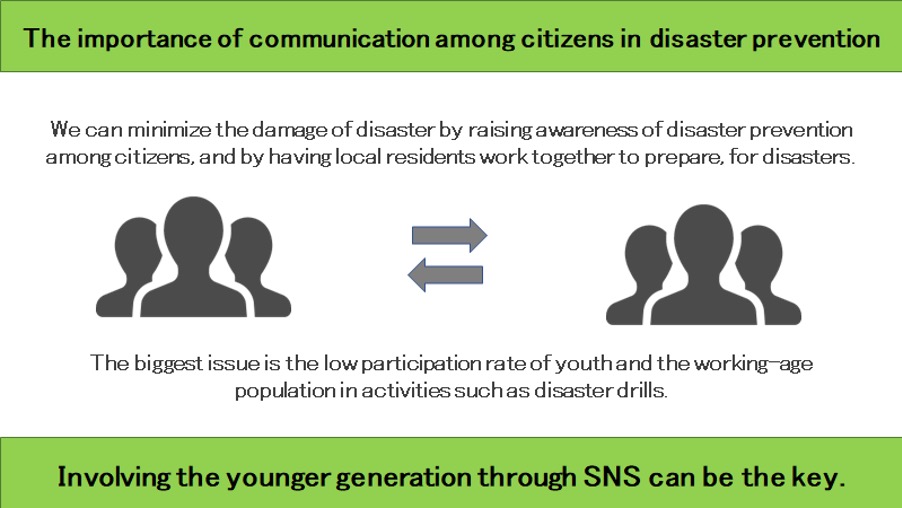
In November last year, KIP conducted a regional study to Kochi where the Nankai Trough earthquake is expected to occur within 30 years. We interviewed Mr. Nakazawa, Deputy Mayor of Kochi City, and members of the Disaster Prevention Department at the Kochi City Office, as well as Mr. Tsutsui and Mr. Nishimura, who are in charge of the Kochi City Disaster Prevention Association. They gave us a lecture and we walked around the Shimoji area of Kochi City. As Kochi City has many areas less than 0 meters above sea level and is located in close proximity to the sea, it was surprising for us to hear that the general public is hardly aware of and is not prepared for natural disasters on a daily basis.
The Shimochi area of Kochi City is a low-lying area between rivers, and there are few tall buildings that can be used as evacuation sites when the tsunami hits the city. Therefore, Mr. Nishimura and other local voluntary disaster prevention organizations are working together with local residents on everything from post-disaster evacuation plans to long-term reconstruction plans. However, it is difficult for all residents to participate in these activities, especially the younger generation such as students and the working-age population in their 30s and 40s, who are less likely to participate in disaster drills. These generations are aware of the fact that Kochi is expected to be severely damaged by the Nankai Trough earthquake, but they do not participate in disaster drills on their days off. People in the Disaster Prevention Department of Kochi City also said that one of the challenges is to raise awareness of disaster prevention by disseminating information to young people.
Needless to say, when a tsunami strikes, all people regardless of age or physical strength are in danger of death. Also, the young generation is expected to support the elderly and other people who need help during evacuation with their physical strength. In Kochi Prefecture, efforts were made to attract the younger generation to disaster prevention by creating mascots.
At present, information on disasters and disaster prevention is generally disseminated through mass media such as TV and newspapers. However, we felt that not enough information is disseminated through social media, which is the most familiar media for the younger generation. No matter how effective the government and voluntary disaster prevention organizations are in preventing disasters, if the information does not reach them, it will not change the behavior of the younger generation. We thought that diversifying information dissemination tools is essential to protect as many lives as possible in times of disaster.
The next article will summarize the learning from the entire training in Kochi, including this interview. Please take a look.
【Article13|Transmitting information in Community ~What we learned through a regional study in Kochi~】
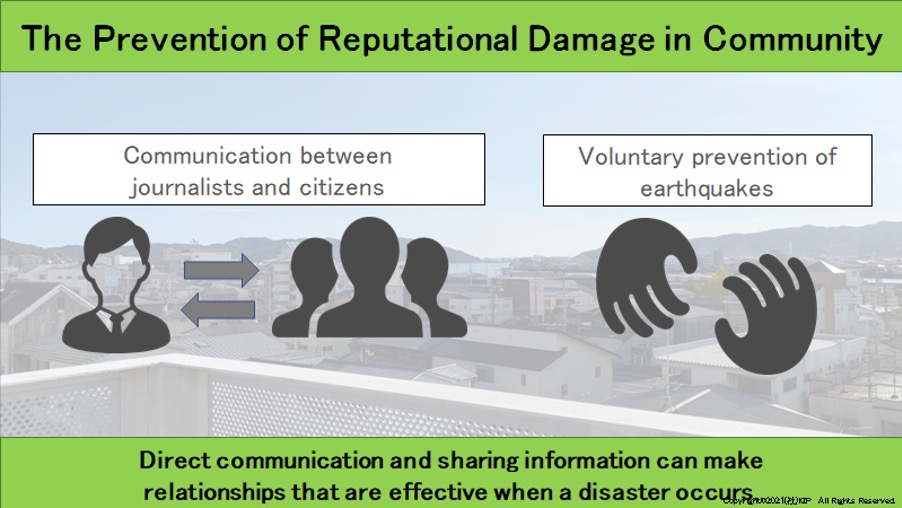
As we mentioned in the former articles about “A Role of Sending the Messages and A Responsibility of Communicating with People about Natural Disasters,” we have had a couple of interviews with victims of the Great East Japan Earthquake, and did much research about the way of communication to learn about reputational damage. Based on former research, we visited Kochi prefecture to see and learn how they prepare and take action to ease the damage of the Nankai Trough earthquake, which is said to occur in the near future, and we found that the community which has a strong connection because of the small number of population was related to reputational damage in some ways.
Kochi prefecture has 700 thousand population, which is a small number compared to that of Tokyo or some other big cities in Japan, and that makes people living there have strong relationships with each other and the local community is well developed. We think that this aspect can prevent people from becoming victims of reputational damage. While regions where the situation of spreading COVID-19 is not too serious, those who are accidentally infected tend to receive slander or their personal information spread widely. Creating close connections between people in the same community is also helpful because the information of disaster can spread easily, and the local people support each other.
To be more specific, as we mentioned in the former articles, two journalists in Kochi told us that after they covered topics regarding the Nankai Trough earthquake, they were able to get feedback from the audiences whether the content is easy to understand or not. It may be difficult for people in big cities to discuss our thoughts about their report with journalists, but in Kochi, different types of people can communicate in such a way, and that would create a great bond to survive from natural disasters. The local people can tell what kind of information they need and journalists can reflect the feedback. Reputational damage is partly caused by the few opportunities to get useful and accurate information, but such interactions and good relationships among citizens and journalists can improve the situation.
In addition, we were impressed by the people in Kochi who tackle disaster prevention voluntarily and help each other. In Shimoji district where we walked around with some members of voluntary organizations for disaster prevention, Mr. Nishimura, who is in charge of the Kochi City Disaster Prevention Association, talked to the people who lived in the district. We thought that it is really helpful to maintain the connection with local people. In the discussion with a member of Kochi University Disaster Assistant Team, the member told that they made an opportunity to interact with local people to get closer. Professor Kawatake, who aims to revitalizeKochi, said that he encouraged students to know more about the economy of Kochi. Through the interviews and the tour of Shimoji district, we found that it is important to have good relationships with neighbors and encourage them to participate in training to ease the psychological damage when a serious disaster occurs.
Moreover, in terms of community, there is another aspect that can change a hard situation for the better. In Susaki city, city government and fisher’s union cooperated to increase sales of sea bream and farmed amberjack which was damaged by the decrease of demand due to COVID-19. When the sales reduced seriously, they used a mascot character and did branding of the fish caught in Susaki city. In order to draw many people’s attention, they also sell zingiber mioga, which is grown in the city. They used the Internet to sell their products to as many people as possible and that bore fruit. In this way, thanks to the strong connection of the local people, they could get through the hard time.
Through a regional study in Kochi, we realized that the strength of people in Kochi is completely different compared to Tokyo. There are, of course, some cases that a bad rumor spreads in the community and the victims receive slanders, but it is important that people who provide information and people who receive it can interact in person. The local people help each other because it can reduce the risk of misunderstanding information or believing fake news.
More and more people communicate through social media or other online tools and we are used to it. It is also important to realize and reflect on our relationships and how our communication with family and friends look like to think whether we can have reliable relationships with them.
【Article14|What can we do?】
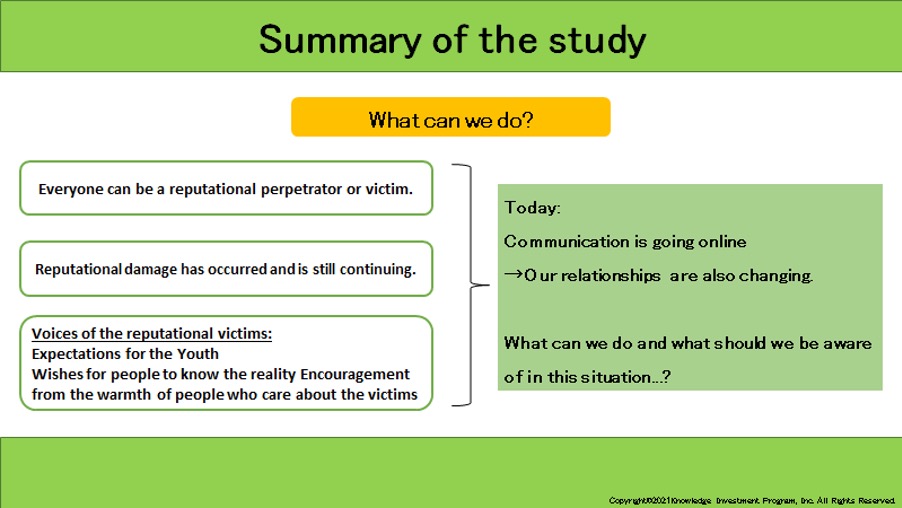
In our previous posts, we have shared our insights from the surveys, interviews, and a regional study we have conducted in our project.
Through the research in our project, we concluded that the mechanism of reputational damage in natural disasters is as follows.
First, bias in reporting based on news value and lack of communication between government and citizens can lead to a lack of information that should be conveyed at the time of disaster.
In a regional study to Kochi in November last year, we heard about the real experience of a journalist. He told us it is inevitable that news is reported based on news value; whether the news is interesting from a general perspective.Therefore reporting that is biased toward specific regions or people or important information that should be conveyed, but not necessarily palatable to the public is not adequately reported.
Interviews conducted on August 30 and October 17, 2020 related to the Great East Japan Earthquake also revealed that the lack of a place for interactive communication between government and citizens and the failure to share the risk of disasters occurring leads to a lack of information that needs to be conveyed.
Second, because of the increase in written communication and lack of trust among citizens due to it, we tend to collect, judge, and interpret information on our own at the time of disaster.
In recent years, with the spread of online communication, written communication has been on the rise and as found in the KIP2018 Survey, many people found it difficult to communicate in written form. Therefore, it becomes more difficult to build trust among citizens. As a result, there will be a lack of reliable sources of information at the time of disaster, and people will tend to collect information and make decisions on their own. Therefore, when accurate information is lacking at the time of disaster, it will take time to gather accurate information and people become anxious that they will not be able to obtain sufficient information, and that this will cause damage to themselves. In practice, the KIP2020 Survey showed that those who spent more time gathering the COVID-19-related information after the declaration of the state of emergency felt such anxiety compared to others.
Then, in order to relieve their anxiety, they interpret the information in a convenient way. Such self-interpreted information is easily spread through social media, and it can be said that this is the cause of reputational damage. This also contributes to the continuation of reputational damage. We found out from surveys and interviews that the prolonged reputational damage caused by the lack of communication of correct facts is occurring.
Biased reporting based on news value, lack of communication between government and citizens, increase in written communication and use of social media, and lack of trust among citizens are common problems that exist even when there is no disaster. Therefore, anyone can be involved in the process of reputational damage, thus anyone can be a person who causes reputational damage, and at the same time, as long as we live in this society, we can also be a victim of reputational damage.
As the above reputational damage occurs and continues, it is important to build trust in ordinary times. In interviews and a regional study, we learned that it is important to view disasters as matter of concern for everyone and to interact across generations and communities, which leads to building trust in ordinary situations. Communication is transforming from face-to-face to online, and the KIP2020 Survey showed that many people under COVID-19 have decreased the amount of communication with friends. In this situation, it is expected to become even more difficult to build trust. As we heard in the interview with Mr. Hatakeyama, it is precisely young people who are expected to send out information using social media and the Internet, and to take action based on their unique perspectives.
We also heard that in order to stop the reputational damage, the victims want people to know the facts and the reality, and that the warm message saying that they are thinking about the victims of rumors is very encouraging.
We suppose what we can do, and what we should be aware of, is to think of the people who are suffering from reputational damage, to be aware of the fact that the trust between the people around us is actually weakening, and to reconsider how we deal with information and connect with others in the age of social media.
【Article15|The importance of thinking of the invisible】
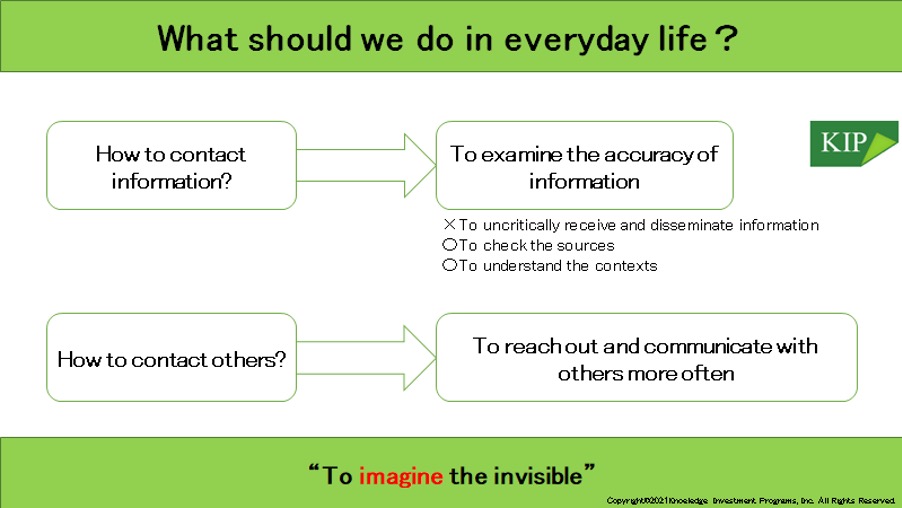
We live in a world where we receive more information than we can handle and can easily “connect” with others through SNS, and so on. Under this situation, it may be easier to search for a great deal of information at once to grasp what is going on, and to interact with many people. However, how to discern and deal with information and to strengthen human relationships online still leaves something to be addressed. It may stand to reason that reputational damage is caused by the spread of misinformation in the event of natural disasters and that the relations between citizens are sometimes not sufficient enough.
In order to prevent this from happening, we think that we should care about how to deal with information and other people. We need to investigate the accuracy of information through several steps. For example, it is desirable to check the sources and understand the contexts that are not always clarified by charts or paragraphs. It is true that such a process may be so troublesome that you might sometimes wish to avoid. But, given that sparing this course can bring about negative effects, perhaps hurting yourself, our attitude towards handling information might be more serious. Also, with regard to building human relationships, it would be necessary for us to try to reach out and communicate with others more often because we see each other less frequently under the COVID-19 pandemic.
We think that in this complex world, to imagine the invisible in our daily lives is a step to make a better society with more people handling information properly and having consideration for others.
Planned and edited by: Knowledge Investment Program, Inc.
Sponsored by: Toshiba International Foundation
Chubei Itoh Foundation


